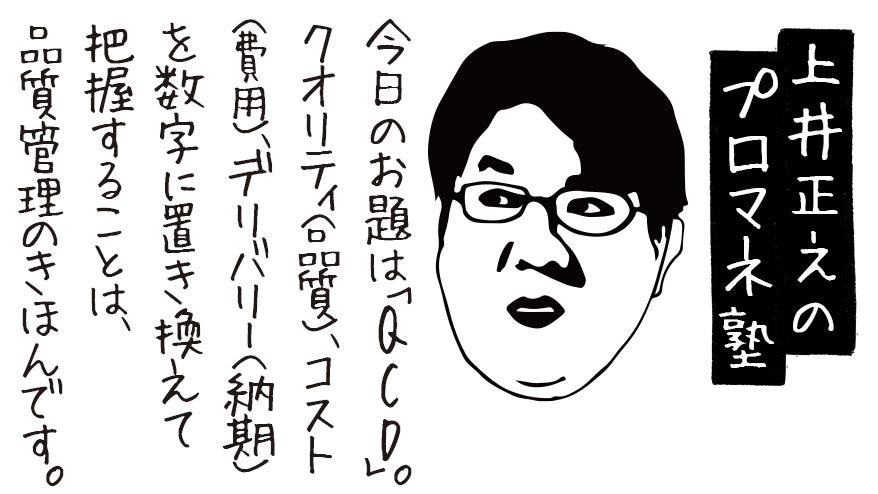こんにちはクリエイティブ部 部長の上井です。
今回で4回目となる「プロマネ塾」の連載。
前回はプロジェクト実施に向けて、WBSに基づいたスケジュール立案や、見積り作成についてお話ししました。
見積り、スケジュールの立案では、「各工程の要求仕様(難易度)=要員の単価」「制作数量」を数値化する必要がありますが、その際に意識する視点が「QCD」です。
これは、「Quality(品質)」「Cost(コスト)」「Delivery(納期)」の頭文字を取った言葉で、プロジェクト要件を定量化して把握するための重要な3つの評価軸です。
第4回目のお題は、「品質管理の基礎知識 その1 QCD(Quality, Cost, Delivery)」 。
製造業における工業製品の設計・生産時の品質管理、品質改善のための活動の中で重視されてきた3つの視点についてお話したいと思います。
連載目次
- 開発工程モデルについて(4月21日公開)
- WBS構築について その1 プロジェクトの筋道を立てる (6月15日公開)
- WBS構築について その2 スケジュール・予算を立てる (8月22日公開)
- 品質管理の基礎知識 その1 QCD(Quality, Cost, Delivery)( ←今回)
- 品質管理の基礎知識 その2 標準化・品質マネジメントシステム〜12月公開予定〜
- プロジェクトの前後を知ろう 〜2月公開予定〜
はじめに

品質管理・品質改善について体系化されたさまざまな知見が、メーカー(製造業)、建築設計、土木設計、建設の分野で活用されています。
これらは、工業製品の大量生産や、大規模な建造物を「計画どおりに作るにはどうしたら良いか?」の知恵と工夫の積み重ねです。
大量生産により数十万個の製品を生産する。高さ数百メートルの建物を建築する。延長距離数百kmの高架橋を建設する。といった生産、建設の現場では、
作り上げるために、何トンもの原材料を調達(購入)したり、何百名もの工員を集めたり、加工・組み立てを行うための巨大な設備を構築する必要があったりします。
そのため、製造や建設の現場では、「品質管理」「品質マネジメントシステム」「標準化」などに取り組み続けています。
もし大量の不良品が発生して、製品が納品できないことになれば、これらを調達した費用や設備への投資が損失に変わることを意味するからです。(時には何千万円!)
「プロマネ塾」連載第4回、第5回では、品質管理に関する先人の知恵をいくつかご紹介します。
1. 「QCD」とは
製造業では、品質管理、生産管理に対する体系化された様々な知見がありますが、その全ての基本となる概念が「QCD」です。
QCDは、「Q」は、品質(Quality)、「C」は、コスト(Cost)、「D」は、納期(Delivery)の3つの言葉の頭文字をつなげたものです。

良い製品とは、「品質が高い」「コストが低い」「納期が早い」の3つの条件を高いレベルでバランス良く満たすことを求められます。
たとえば、納期を短くして他社よりも「より早く」「より多く」の製品を製造することで、競争力を高めようと考えた場合、以下のような対応が考えられます。
- 2交代制や3交代制の製造シフトとして、工場を24時間稼働させることで、納期 (Delivery)を短縮する。
- 3交代制(日勤、準夜勤、夜勤)における「準夜勤」「夜勤」は割増賃金となるため、人件費(Cost)が増大する。
- 原材料の、コスト (Cost)は変化しない。
- 工場の占有期間が短縮されるため、工場設備の固定費 (Cost)を削減できる。
- 工場などの大型施設の場合、夜間電力料金による電力量料金 (Cost)の削減ができる。
このように、「Q(品質)」を変えずに、「D(納期)」を短縮する場合、「C(コスト)」を決める条件が変化することが分かります。
「QCD」3つの要素は、製品の設計・製造から出荷までの一連の流れのなかで相互に影響しあう関係にありますが、一方で「QCD」各々に独立した評価基準によるチェックを徹底する必要があります。
そのため、製造業を営む企業(メーカー)では、QCDそれぞれを管理する部門が独立していることが一般的です。
設計部門、製造部門、営業部門とは独立した、品質管理部門、コスト管理部門、生産管理部門が置かれています。
たとえば、完成した製品の納品前のチェックを品質管理部門が行いますが、規定の品質に達していなければ出荷を差し止める権限を持たされています。
QCDは「DCQ」や「CQD」など異なった並びで表記されることがありません。これは3つの要素の中で最も優先すべきは「Quality(品質)」であるからです。
工業製品は、ある基準以上の品質を満たさなければ、機能しなかったり、商品としての価値が生まれません。「価格の安さ」「納品が早い」を向上させることは、競合他社との差別化、優位性となりますが、「品質第一/Quality First」という言葉があるように、ユーザーが求める品質に達していることが大前提となります。
次に「プロジェクト管理」「リソース管理」それぞれの QCD について、見ていきたいと思います。
2. プロジェクト管理における「QCD」
「QCD」3つの視点は、Web制作やシステム開発のプロジェクト管理にも当てはめることができます。
連載第3回で、プロジェクトの全体像を把握するには、要求仕様、予算、スケジュールの3つの要素を明らかにする必要があるとお話しました。
この3つの要素も、「Quality(要求仕様)」「Cost(予算)」「Delivery(スケジュール)」と書き換えると、これも「QCD」の視点であることが分かります。
プロジェクトの要求仕様から、見積り(予算)とスケジュールを計画する手順を「QCD」に当てはめて整理すると以下の手順になります。
① 要求仕様の整理:Quality
- 工程ごとの成果物の内容・難易度と制作数量を整理する
- 要員のスキルセット(単価)・工数を算出する
② 見積り(予算):Cost
- 要員の単価 × 工数 により工程ごとの費用を算出
③ スケジュール:Delivery
-
工程ごとの工数に基づきスケジュール化する
3. リソース管理における「QCD」
プロジェクトの体制を計画する際に、要求仕様で示された成果物の内容・難易度に応じて、メンバーを選定していきますが、メンバーのスキルセットの把握に必要な視点も「QCD」であることがわかります。
① 対応可能な技術レベル:Quality
- 対応可能な技術の種類
- それぞれ技術における対応可能な難度のレベル
② 単価:Cost
- 時間単価
③ 工数:Delivery
- 単位数量の生産にかかる工数(単位時間あたりの生産性)
メンバーの持つ技術を「QCD」の視点で評価し、スキルを定量的に把握することで、成果物の仕様変更や、プロジェクトのスケジュール変更が発生した場合にも、要員の「単価」「工数」の数量に置き換えて、速やかに調整することができるようになります。
4. 標準化と品質マネジメントシステム
第4回目は、品質管理の基礎知識として、プロジェクトを構成する様々な要素を定量的に把握するために必要な視点「QCD(Quality, Cost, Delivery)」についてお話ししました。
次回も引き続き、品質管理の基礎知識 その2として、「標準化」と「品質マネジメントシステム」を紹介します。
「どのホームセンターで買ってきたネジでも、ちゃんとネジ止めできるのはなぜか?」(標準化)
「建築物、橋やトンネルの設計ってどんなことをしてるの?」(品質マネジメントシステム)
といったことをお話しする予定です。
それではまた、12月に。
